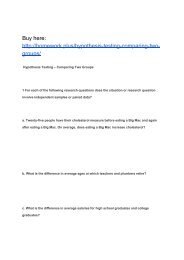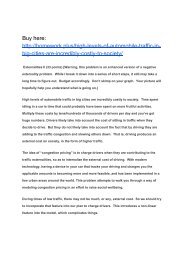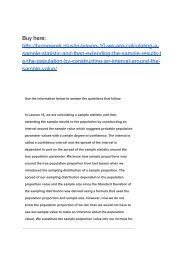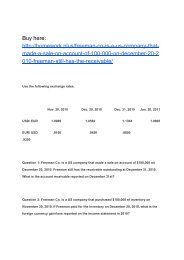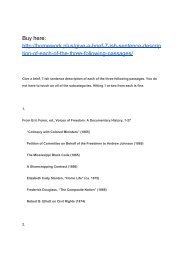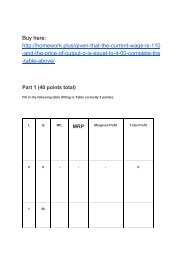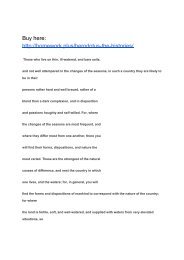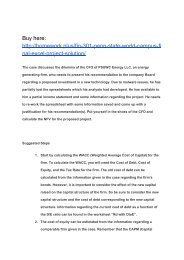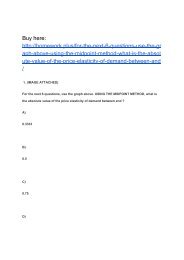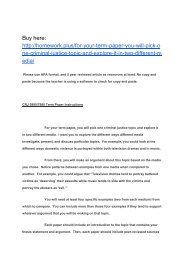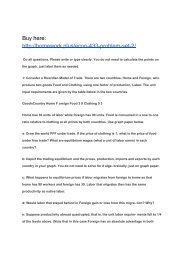Econ 444 Problem Set #1
Econ 444 Problem Set #1
Econ 444 Problem Set #1
Create successful ePaper yourself
Turn your PDF publications into a flip-book with our unique Google optimized e-Paper software.
Buy here:<br />
http://homework.plus/econ-<strong>444</strong>-problem-set-1/<br />
<strong>Problem</strong> 1. Suppose that, in a large city, 100 identical street vendors compete in a<br />
competitive market for ice-cream.<br />
1. Fore each vendor i, total cost of producing qi ice-cream is, Ci(qi) = qi + 1qi2. 4<br />
2. What is the marginal cost function of each firm?<br />
3. Given your answer from above, how many units of ice-cream will each vendor<br />
produce if offered a price of $5 per ice-cream? What is the marginal revenue<br />
of the firm at this price?<br />
4. What is the aggregate supply curve for this market?<br />
5. Let demand for ice-cream be Q = 1600−100P , what is the short run equilibrium<br />
price?<br />
6. What is the total quantity of ice-cream sold in short-run equilibrium?<br />
7. In the long run, would you expect this industry to experience entry or exit?<br />
Explain your answer.<br />
<strong>Problem</strong> 2. In the same city as before, a new fast prepare ice-cream (FI) tech-<br />
nology is discovered. Firms using this new technology have a total cost function<br />
CFI(q ) = 2q + 1 q2. While the 100 existing firms keep their old, regular ice-cream ii i20i<br />
(RI), technology, ten new firms enter using FI technology. The ice-cream produced by the<br />
two technologies tastes exactly the same to consumers (that is, ice-cream is<br />
homogeneous). You may assume there is free entry in both technologies in the long run.<br />
<strong>Econ</strong> <strong>444</strong>: <strong>Problem</strong> <strong>Set</strong> <strong>#1</strong> 2
1. The promoters of FI technology point out that although it may appear more<br />
expensive at first, it benefits from greater ”economies of scale” than RI.<br />
Explain what they mean, feel free to use a numerical example.<br />
2. What is the individual supply curve of a firm using FI technology?<br />
3. Given that there are now 100 RI firms and 10 FI firms, what is the aggregate<br />
supply curve for this market?<br />
4. What is the new short-run equilibrium price in this market?<br />
5. Is the market in long-run equilibrium? Explain why or why not.<br />
6. You are hired as a consultant by a firm using FI technology. What do you<br />
suggest they do?<br />
<strong>Problem</strong> 3. Suppose Global Shoveling Co. has gained exclusive rights to shovel snow in<br />
State College. The demand for shoveling is given by Q = 3000 − 30P . The total cost<br />
function for shoveling is C(Q) = 6Q for Q miles of road.<br />
1. What is the marginal cost function for Global Shoveling Co.?<br />
2. Write down the monopolist’s maximization problem, assume the monopolist<br />
3. chooses how much road to shovel.<br />
4. How much road should Global Shoveling Co. shovel in State College?<br />
5. What is the price at this level of output?<br />
6. Is this outcome efficient? If so, why? If not, what is the efficient level of<br />
output?<br />
7. What is the Lerner Index for Shoveling services in State College? What about<br />
the HHI?<br />
8. Suppose the demand for shoveling services in State College was instead<br />
given by Qd = 3000 − 100P . How would Global Shoveling Co. Lerner index<br />
change? Would this lead to a more or less efficient outcome? Explain.<br />
<strong>Econ</strong> <strong>444</strong>: <strong>Problem</strong> <strong>Set</strong> <strong>#1</strong> 3 <strong>Problem</strong> 4. The following firms compete within the same<br />
industry:
Name<br />
ACME Industries Beta Inc.<br />
Caltech<br />
Douglass Ltd. Gramen Inc. Houghton Enterprises Jenentech<br />
1. Use this information to calculate CR3<br />
2. Calculate CR5 for the industry.<br />
3. What is the HHI for the industry?<br />
Sales (millions) 50 18 18 4 11 22 5<br />
4. Can you use this information alone to calculate the Lerner Index? Explain why or why<br />
not. What information would you need?<br />
<strong>Problem</strong> 5. True or False. In each part, state whether the sentence is true or false and<br />
explain your assertion. You will receive half the credit for the correct answer and half the<br />
credit for the correct explanation.<br />
1. In a perfectly competitive market, firms produce optimally at the point where<br />
marginal revenue equals marginal cost.<br />
2. A monopolist may sometimes produce on the inelastic portion of the demand<br />
curve.<br />
3. In equilibrium, the quantity produced by a monopolist is greater when (downward<br />
sloping) demand is more inelastic.



